Review: What made Van Gogh tick? A Santa Barbara show offers surprising answers
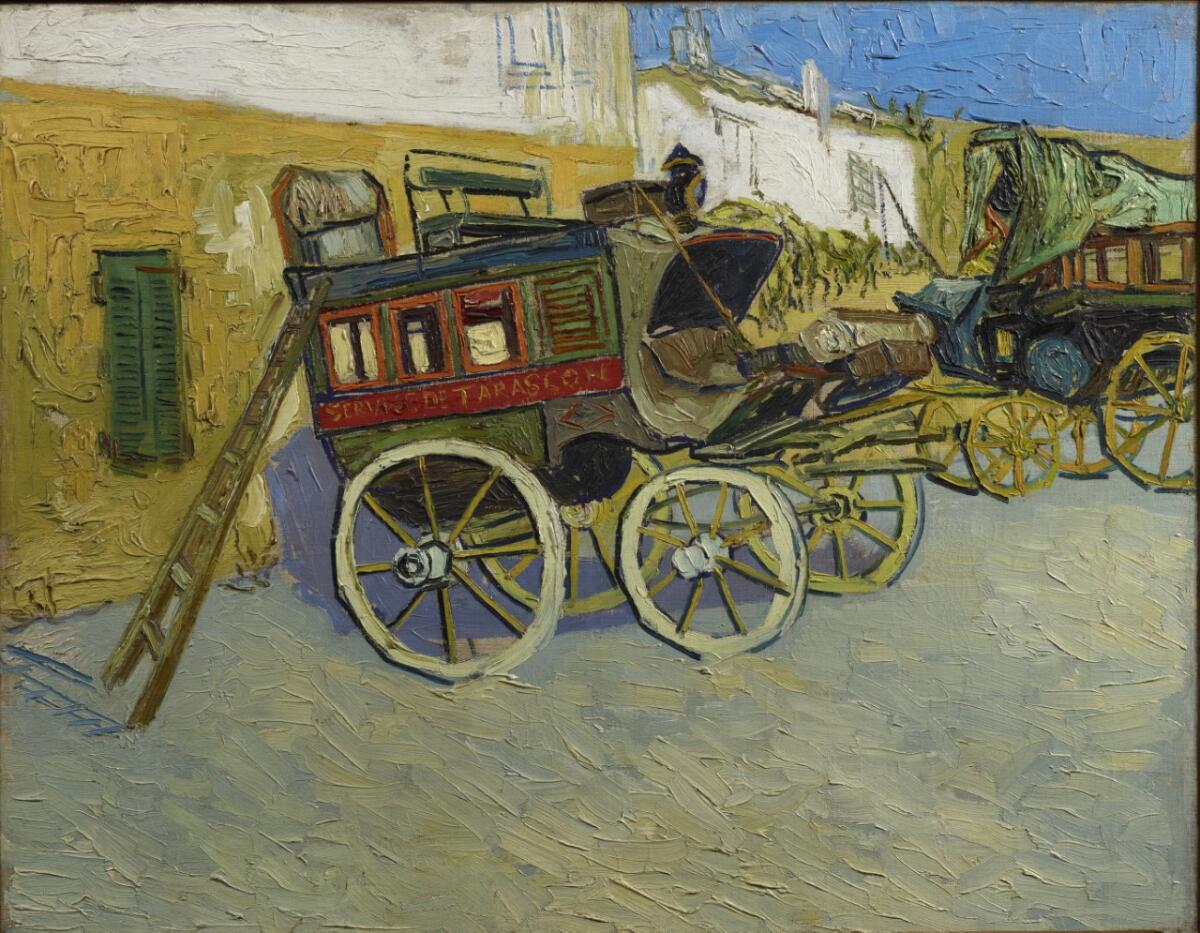
- Share via
SANTA BARBARA — Artists look to other art by other artists for cues on how to make their own work. Art is a giant conversation among artists about navigating human experience, and this is one way in which it speaks with breadth and conviction.
Vincent Van Gogh (1853-1890) took his cues from scores of contemporaries, as well as from painters from the recent past, mostly French. Partly that’s because the Dutchman started painting relatively late in his difficult life, at the age of 27, and he needed to catch up fast.
A surprisingly engrossing exhibition at the Santa Barbara Museum of Art digs into the wide-ranging sources on which Van Gogh drew during the 10 short years in which he worked, demonstrating a voracious appetite. It’s surprising because a show like this, surveying influence, is tough to pull off. “Through Vincent’s Eyes: Van Gogh and His Sources” puts together 20 of his paintings, dispersing them throughout galleries filled with 75 examples by 62 other artists.
Some works (mostly on paper) didn’t make it to Santa Barbara in time for a preview due to pandemic-related shipping issues, especially from Amsterdam’s Van Gogh Museum. (According to a spokesperson, they have now been installed.) But there was still plenty to see — the show continues through May 22 — and the sources from which the artist drew are often fascinating.
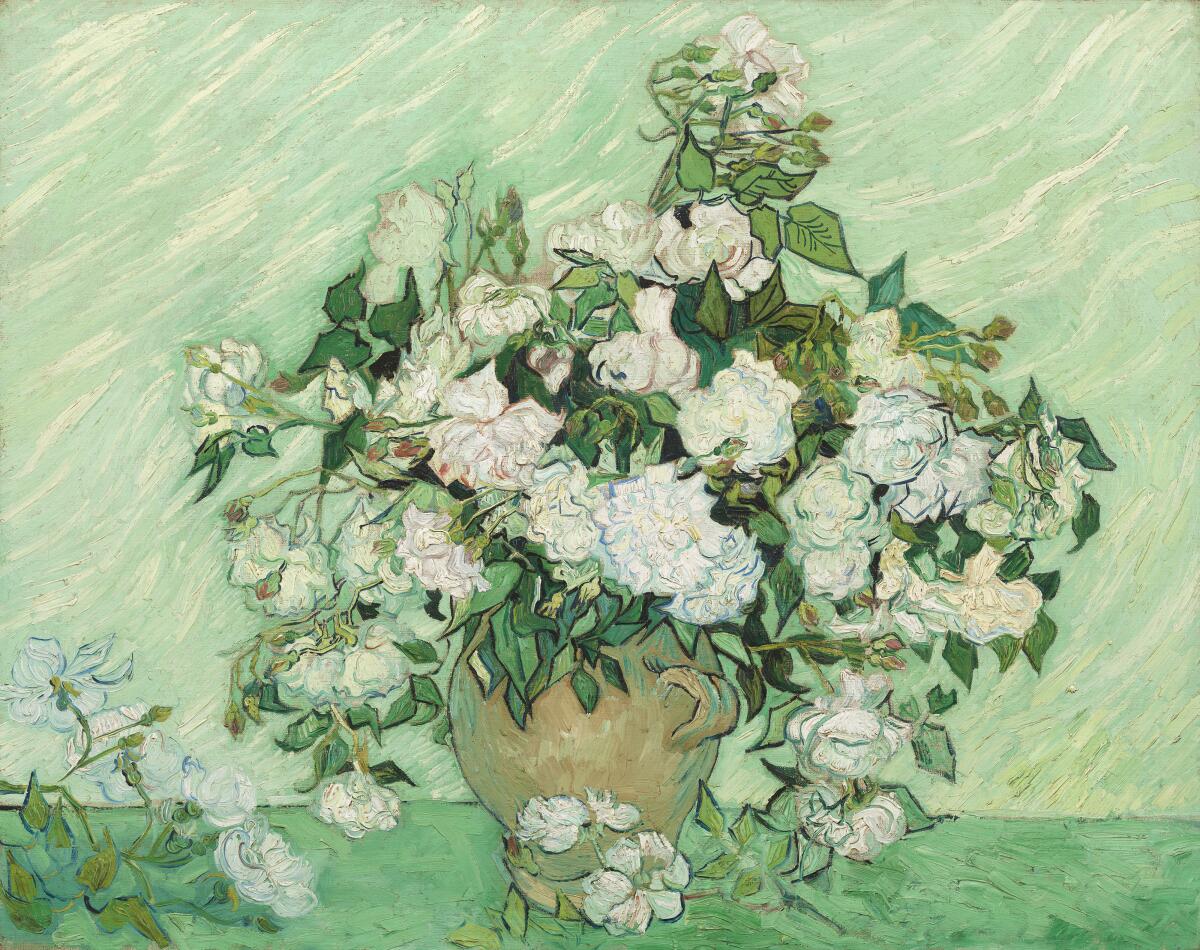
Does the name Adolphe Joseph Thomas Monticelli (1824-1886) ring a bell?
Probably not, unless you happen to be a scholar in the field of mid-19th century French painting. Largely forgotten today, the artist from Marseille was a friend of Paul Cézanne’s, with whom he sometimes went on landscape painting excursions in the South of France.
Van Gogh was crazy about Monticelli’s work, which he stumbled on in an exhibition during his first visit to Paris in the year the older artist died. So crazy, in fact, that he and his art-dealer brother, Theo, were instrumental in the posthumous publication of a book about the work.
Van Gogh’s interest has long been known, if difficult to grasp. There are more paintings by Monticelli — eight in all — on view in the Santa Barbara show than by any other artist save Vincent, and that includes brilliant household names like Eugène Boudin, Jean-Baptiste-Siméon Chardin, Edgar Degas and Claude Monet, all represented by fine examples. Most by Monticelli are small, but the number and their placement on a separate wall near the entry emphasize his critical importance to Van Gogh’s development, which was in the early stages of taking off when he encountered the painter from Marseille.
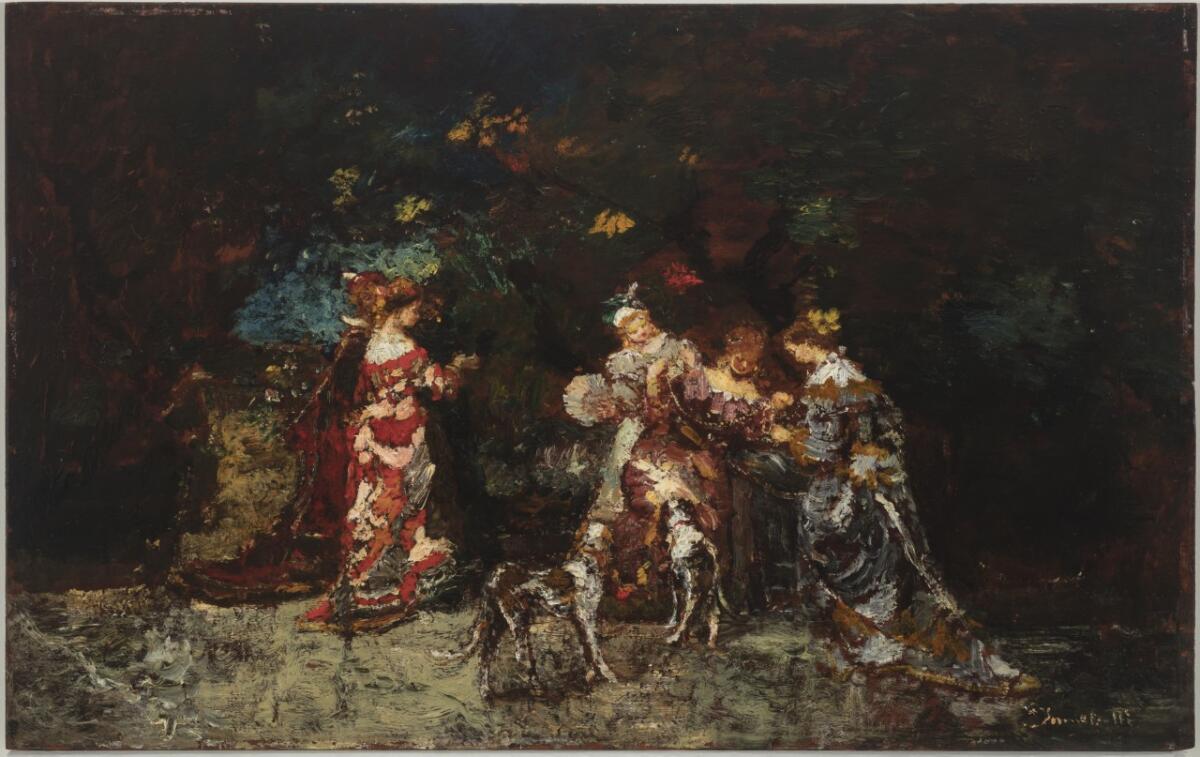
Jean-François Millet, whose empathetic pictures of peasant farmers are graced with a heroic monumentality, as in the imposing “The Sower” spreading seeds across tilled soil from a weighty shoulder sack, usually has pride of place in understanding Van Gogh’s artistic origins. Or Eugène Delacroix, who wrestled color with brushwork like Jacob wrestling with the angel in Genesis. Or sometimes even Jean-François Raffaëlli, whose soulful picture of two homeless men drowning their sorrows in glasses of absinthe shows why he was regarded as the urban Millet.
But here’s the thing: Monticelli’s paintings differ from those because they are almost uniformly ugly.
Dark, clotted surfaces; from the gloom, awkward bursts of brusque color and vivid light; odd subjects, like romantic scenes of clumsy young ladies clustered together in parklike settings (shades of aristocratic picnics by Jean-Antoine Watteau) — it’s no wonder he’s an obscure figure today. They are very hard to like. It takes a moment to begin to see what Vincent might have seen in them.
But slowly, it does emerge in these modestly scaled but jam-packed pictures, from Monticelli’s reverence for Delacroix’s fulsome brushwork to his sensitivity to mortality embedded in the fragility of a simple bowl of flowers. This and more would add fuel to the growing intensity of Van Gogh’s fire.
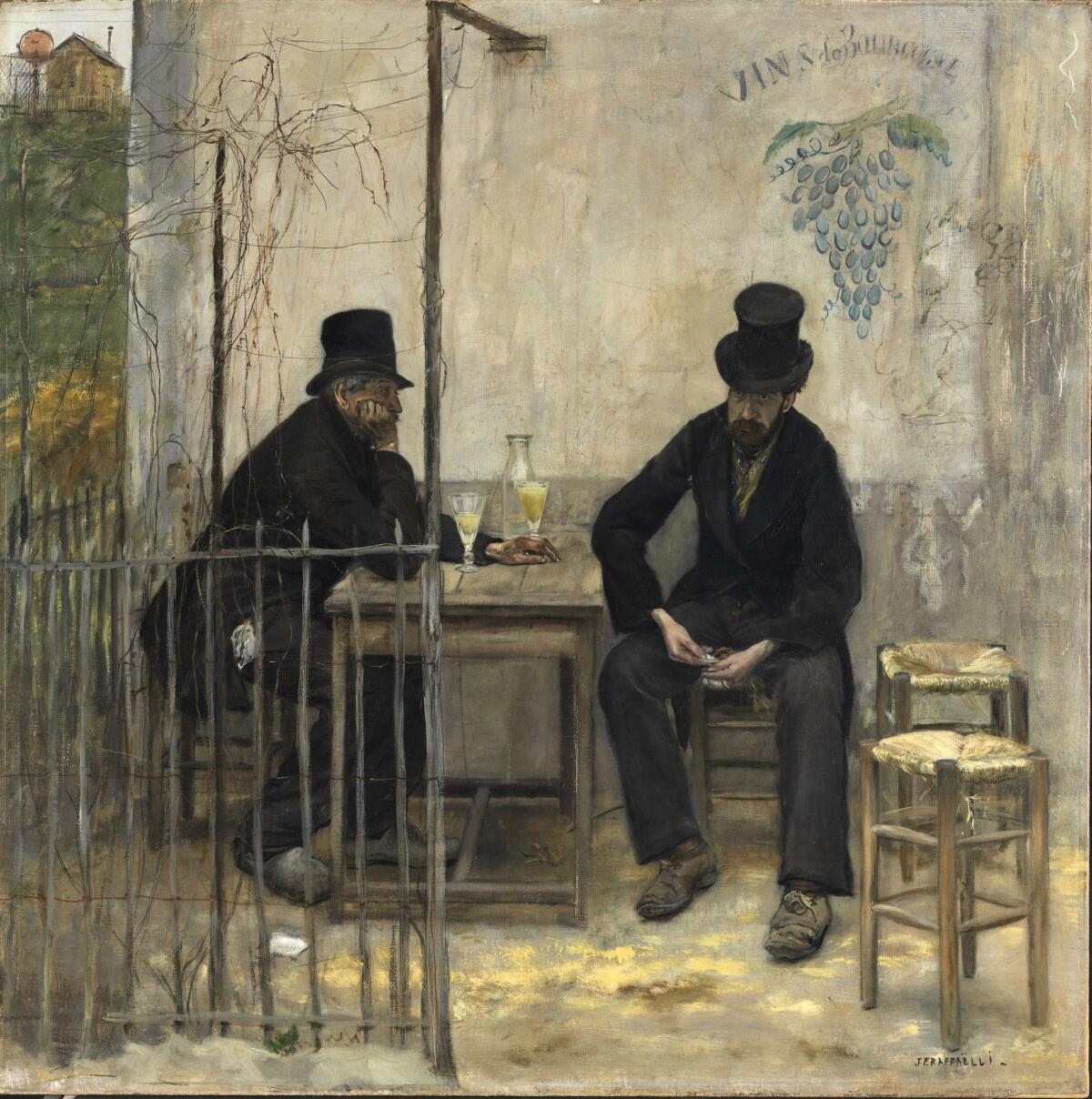
“Through Vincent’s Eyes” is not a masterpiece show. Spectacle is not on the docket. Of the 20 pictures by him gathered here, just four are of the first rank. All those are from the last two years of his life — peak Van Gogh.
“Tarascon Stagecoach,” rendered in a thick impasto he attributed to Monticelli’s influence, plus vivid red and green hues he accredited to Monet’s chromatic splendor, was painted in anticipation of Paul Gauguin’s impending visit to Van Gogh’s Yellow House in Arles.
“Roses,” also partly inspired by Monet, is an extraordinarily abundant vase of white blooms set on a dark green table against a light green wall, rhythmic cascades of white light falling on a diagonal behind it. To accent the flowers, Van Gogh employed a vibrant crimson pigment that has unfortunately faded over passing decades, the now-pinkish color losing its punch with the complimentary green.
Yet, the churning forms of the still life, which is anything but still, can barely contain an ecstatic dynamism. These are flowers living joyfully despite inevitable demise.
Ditto the virtually flaming cedars and pine trees that rise skyward before the yellow and blue “Hospital at Saint-Rémy,” the psychiatric facility where the artist stayed not long before his death. (Visitors from Los Angeles will recognize the stunning painting from the collection of the UCLA Hammer Museum.) The fine catalog to “Through Vincent’s Eyes” points to the anthropomorphism of those undulating trees, which seem to dance furiously in the vivid light of a bright blue sky, just outside the hospital’s confines.
Speaking of dancing, “Sheaves of Wheat” radiates all the formal elegance of a rustic cotillion, a marvelous panoramic close-up of bundled, golden wheat casting pale blue shadows. One among a group of so-called “double square” paintings, exactly twice as wide (40 inches) as they are high, it dates from just days before Van Gogh died. “Wheatfield With Crows” is the most widely known of the double squares.
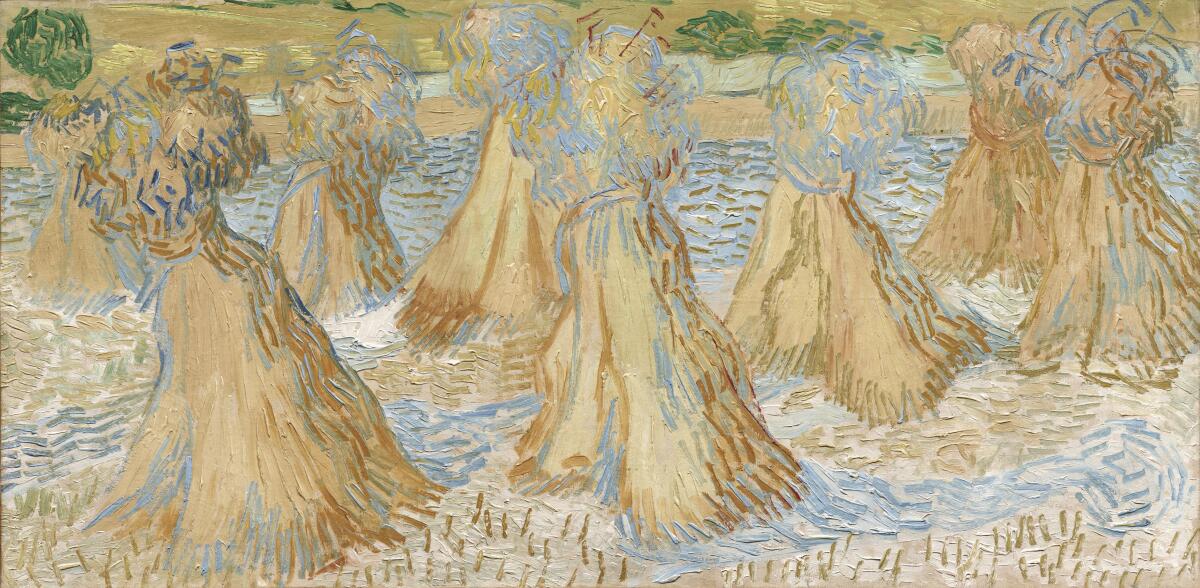
“Wheatfield with Crows” is not in the exhibition, which was smartly organized by SBMA deputy director and chief curator Eik Kahng in association with Ohio’s Columbus Museum of Art, where a somewhat different version was seen over the winter. (The late Gregory White Smith, whose widely admired 2011 biography of the artist, “Van Gogh: The Life,” written with his husband, Steven Naifeh, grew up in Columbus.) The famous painting of black birds swooping skyward from a rustling wheat field, one of the artist’s final canvases, is worth mentioning because it has become an almost cinematic emblem of a problem that the current exhibition means to untangle.
The popular myth of the melancholic madman as suicidal artist churning out masterpieces born of a tortured psyche on his way out the door has made it very hard to see Van Gogh authentically. “Through Vincent’s Eyes” successfully pulls the plug on that folkloric view.
Simply put, it’s a show about how artists actually work. There’s a lot to discover here, and the 16 “lesser” Van Gogh paintings are as necessary to it as the flat-out masterpieces — not to mention those very peculiar Monticelli pictures.
'Through Vincent’s Eyes: Van Gogh and His Sources'
Where: Santa Barbara Museum of Art, 1130 State St.
When: Tuesdays-Sundays, through May 22
Admission: Special exhibition pricing is $10-$25; children under 6 are free
Info: (805) 963-4364, sbma.net
More to Read
The biggest entertainment stories
Get our big stories about Hollywood, film, television, music, arts, culture and more right in your inbox as soon as they publish.
You may occasionally receive promotional content from the Los Angeles Times.











